Product Requirements:
Device:
Pilot 1000, 5000, Palm III series, Palm V series,
Palm VII series, Palm m100 series
PocketKeys.prc 15k
The Pocket Keyboard by Cirque is a small input device that plugs into the hotsync port on a Pilot 1000, 5000, Palm V series, Palm III series, Palm VII series or m100 series PDA.
There is also a version available for the Handspring™ Visor™, Deluxe,
Platinum, and Prism.
I had seen a picture of this little accessory on the web a few months ago and was interested in taking a look at it. Then last weekend while wandering around in a Staples store in Bloomington, IN, I saw a
Fellowes branded version of this device. Looking thru the packaging, I thought it was a membrane type of keyboard. The keys looked like they were little raised circles. It looked interesting, so I bought it.
After I got it home and opened the packaging, I was surprised that the keys were not raised at all, but perfectly flat. The raised effect was only an illusion due to the actual
silk-screened graphics. Just playing around with the keyboard before even attaching it to the PDA, I thought ‘this thing is going to be crappy’… Mainly I thought this because the keys
had no tactile feedback at all. They were just printed on a hard surface.
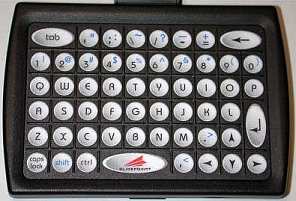
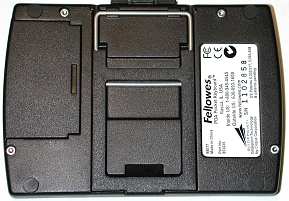
Included with the keyboard was a 3.5 floppy and two small connectors. One connector allows the keyboard to be used with the Palm V series PDAs, and the other connector allows the keyboard to be attached to a Pilot 1000, 5000, Palm III series, Palm VII series or m100 series PDA. I thought it was really cool that they packaged both connectors with the keyboard. Not that most people have more than one model Palm, but I do! 🙂 The connector snaps snuggly into the top of the keyboard.
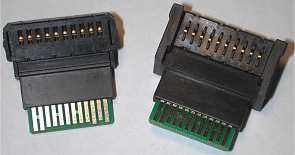
After you insert the correct connector for your PDA, you have to install the keyboard driver on the floppy. The driver is a simple program that allows you to toggle the keyboard on or off, toggle the key sound, toggle the auto-off alarm, adjust the touch sensitivity, adjust the auto-off timeout, adjust the key repeat rate and adjust the key repeat delay. I left all the settings at their default values.
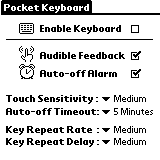
After the driver is installed, you can attach the keyboard to your Palm and enable it via the driver settings. Unfortunately, the driver doesn’t ‘sense’ when the keyboard is attached. It does however know when you remove it. So, every time you want to use the keyboard you have to go into the settings and enable it.
Once I finished these steps, I used my stylus to navigate to the memopad application and opened a new memo. Then I started to press a key
on the keyboard and almost jumped when after barely brushing the key, the PDA beeped and the key I
had touched was displayed on the screen. I began touching keys and was genuinely surprised that I didn’t have to press them in order for them to register. Typing with it almost felt like magic.
The reason for this magic feeling is that the Pocket Keyboard is a capacitive touch panel based on Cirque’s award winning GlidePoint technology. Below the electrically-insulating surface lies a sophisticated sensor system which responds to the most precise finger movements. The system is based on electrical capacitance and does not require pressure or direct contact.
How it works (taken from the Cirque website):
"The GlidePoint trackpad contains a two-layer grid of electrodes which are connected to a sophisticated full-custom mixed signal integrated circuit (IC) mounted on the reverse side of the pad. The upper layer contains vertical electrode strips while the lower layer is composed of horizontal electrode strips. ‘Mutual capacitance’ from each of the horizontal electrodes to each of the vertical electrodes is measured by the IC. A human finger near the
intersection of two electrodes modifies the mutual capacitance between them, since a finger has very different dielectric properties than air. Position of the finger centroid is precisely determined based on
these mutual capacitance changes at various locations and can be detected before
a finger actually touches the pad."
That’s the geek explanation. Let’s now look at the actual product.
Hardware Specifications:
Length: 3.850 x 2.685 x 0.400 in. (97.79 x 68.20 x 10.16mm)
Weight: 1.9 oz. (53.86g)
Power: 2 CR2032 Lithium Coin Cells – 3V (average battery life is 30hrs of
constant typing)
I tried the Pocket Keyboard with my Palm V, Palm VIIx, Palm m100, Palm IIIc,
and Palm III and they worked equally well with the appropriate connector.
The keyboard is a nice size as far as portability. It is very solid and feels
and looks like you could throw it across the room without breaking it. The keyboard has a nifty little fold-out support arm on the bottom that the PDA can rest against while using it on a flat surface. You can also use the
combination one handed while holding the PDA / Keyboard combo in your other hand.
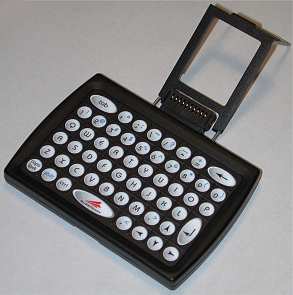
The key areas are pretty small and are separated by a raised grid which keeps you from touching two areas at once. Due to the fact that you can only have one finger on the keyboard at a time, shifting letters takes a little to get used to. You have to touch the shift key and then the
desired key to shift. You also have to use your finger, tapping on the keyboard
with a stylus will have no effect at all.
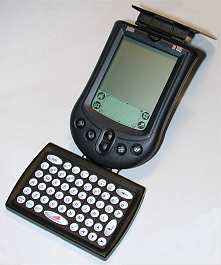
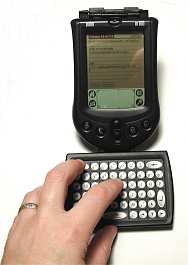
You can’t actually touch-type with this keyboard, but it is surprising how
fast you can type with it just using two fingers. You have to be careful to not
brush your fingers on the keys accidentally because any contact with the
keyboard surface will yield a key press.
I found the Pocket Keyboard to be a surprisingly interesting little peripheral
that although isn’t something that will replace my beloved Stowaway,
it is something that I would love to see in a bigger touch-type version in the
future. For those of you that are already "hunt and peck" typists, I
think this little doo-dad could be a welcome addition to your gadget bag.
Price: $41.95
Pros:
Small
Inexpensive
Cons:
Can’t touch-type on it
Small keys
No tactile feedback
Gerber Gear Suspension 12-in-1 EDC Multi-Plier Multitool with Pocket Knife, Needle Nose Pliers, Wire Cutters and More, Gifts for Men, Camping and Survival, Grey
25% OffCAMVATE Folding 6-in-1 Multi-Tool Kit(Blue)-3801
$9.90 (as of December 9, 2025 21:48 GMT -05:00 - More infoProduct prices and availability are accurate as of the date/time indicated and are subject to change. Any price and availability information displayed on [relevant Amazon Site(s), as applicable] at the time of purchase will apply to the purchase of this product.)Product Information
| Price: | 41.95 |
| Manufacturer: | Cirque |
| Pros: |
|
| Cons: |
|


